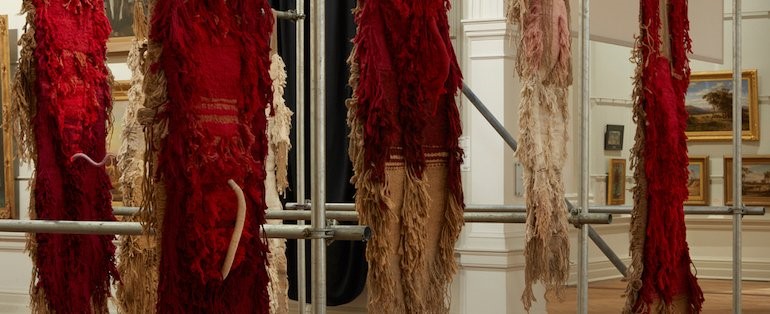“There might be no other place in the world as good as where I am going to take you,” textile weaver Joël Andrianomearisoa told me as he showed me around his Biennale exhibit.
He led me through a series of thick floor to ceiling curtains that divided the art works at the Museum of Contemporary Art.
His abstract textile installation veils and drifts between solid descriptions of space, shifting with our perceptions of what we can and can’t see.
The works being shown at the 22nd Biennale of Sydney Nirin 2020 deal with ideas of floating through space and playing with perceptions of memory and emotion.
And importantly the Biennale currently remains open with various safeguards against the coronavirus and is free to get in.
Presenting 101 artists, 700 works and 600 events over 87 days, the exhibition is one of the most important showcases of the work of innovative Australian and international artists. In a media preview I spoke with various artists abut the cutting edge show, which is appropriate as nirin means ‘edge’ in the Wiradjuri language.

Barbara Moore, CEO of Biennale of Sydney, said the exhibition draws heavily on Aboriginal communities such as the Gadigal people of the Eora Nation and Boorooberongal people of the Dharug Nation and the presentation of art on their ancestral land and waters.
Brooke Andrew, Artistic Director who arranged the Biennale event, said: “Nirin is a safe place for people to honour mutual respect and the diversity of expression and thoughts that empower us all.”
He added Nirin pushes audiences to see beyond what they know, to challenge history, to be a part of the story and to immerse themselves in inspiration and imagined futures.

Among the other works a large-scale textural installation by one of the artists being exhibited Josep Grau-Garriga, Retaule deis penjats (Altarpiece of the Hanged People) 1972-76, acts as a gesture of memorialisation within a context where histories of war and martyrdom are interwoven.

On Cockatoo Island, we meet a few aboriginal artists from Iltja Ntjarra, Namatjira School of Art.
The paintings of Mervyn Rubuntja range from beautiful landscapes of the Northern Territory to people in urban environments and raises awareness about issues his people face.

“Homes are destroyed,” he says. “There’s no support in housing for my people… the government takes everything! They take too much!”

Lhola Amira’s works symbolise healing through connection to the earth, the ancestral, and the spiritual. They create portals for memory and rejuvenation, where one may step through a beaded curtain onto a ceremonial healing bed of salt, to hear the sounds of singing, to listen and remember.

The art works are expressions from all walks of life; from loss of homes, diversity and opening the door to anything you can imagine. It’s not about just seeing the art displayed before you, it’s about understanding what each piece means to every artist.
With works from around the globe the Biennale of Sydney 2020 Nirin is being held at various venues across Sydney, including the National Art School, Campbelltown Arts Centre, Artspace, Art Gallery of New South Wales, the Museum of Contemporary Art Australia and Cockatoo Island, until June 8.


